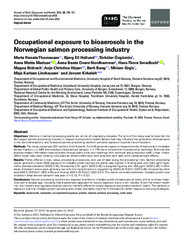| dc.contributor.author | Thomassen, Marte Renate | |
| dc.contributor.author | Hollund, Bjørg Eli | |
| dc.contributor.author | Özgümüs, Türküler | |
| dc.contributor.author | Madse, Anne Mette | |
| dc.contributor.author | Nordhammer, Anna Beathe Overn | |
| dc.contributor.author | Smedbold, Hans Thore | |
| dc.contributor.author | Bråtveit, Magne | |
| dc.contributor.author | Höper, Anje Christina | |
| dc.contributor.author | Bang, Berit | |
| dc.contributor.author | Grgic, Miriam | |
| dc.contributor.author | Linchausen, Maja Karlsen | |
| dc.contributor.author | Kirkeleit, Jorunn | |
| dc.date.accessioned | 2025-08-11T07:22:38Z | |
| dc.date.available | 2025-08-11T07:22:38Z | |
| dc.date.issued | 2025-06-29 | |
| dc.description.abstract | Objectives - Workers in salmon processing plants are at risk of respiratory diseases. The aim of this study was to describe the Norwegian salmon processing industry in respect to production-related factors that may influence the generation of bioaerosols in the work atmosphere, and to assess salmon processing workers’ personal exposure to protein and endotoxin.<p>
<p>Methods - The study comprised 222 workers from 9 plants. Fullshift personal exposure measurements of total protein (inhalable aerosol fraction, n = 380) and endotoxin (total aerosol sampler, n = 178) were collected on 4 consecutive workdays. Technical and process-related information was collected through plant visits and meetings with technical and production staff. Linear mixed-effect model was used, treating individuals as random effect and work area and work task within areas as fixed effects.<p>
<p>Results - Plants differed in size, setup, processing procedures, and use of labor along the processing lines. Salmon processing overall geometric mean (GM) exposure to inhalable protein across the plants was highest in filleting area with 4.83 µg/m3 (geometric standard deviation [GSD] 3.16), followed by 3.91 µg/m3 (GSD 2.42) in slaughtering area, and 1.68 µg/m3 (GSD 2.40) in other areas. Endotoxin levels were generally low with the highest levels in slaughtering (GM 0.24 EU/m3; GSD 3.48), followed by other area (GM 0.19 EU/m3; GSD 4.05) and filleting (GM 0.10 EU/m3; GSD 2.51). The overall correlation between inhalable protein and endotoxin (total aerosol sampler) was poor (r = 0.13, P = 0.12).<p>
<p>Conclusions - Salmon processing workers are exposed to airborne inhalable protein bioaerosols at levels similar to those measured over a decade ago, indicating that a systematic approach to reduce exposure levels is still needed. Given the known health risk, the industry and regulatory bodies need to intensify efforts to reduce exposure and protect workers’ health. The variance in exposure levels to inhalable protein across plants, areas, and tasks might form the basis for better exposure-reducing strategies. | en_US |
| dc.identifier.citation | Thomassen MR, Hollund BE, Özgümüs T, Madse, Nordhammer A, Smedbold HT, Bråtveit M, Höper AC, Bang BE, Grgic M, Linchausen M, Kirkeleit J. Occupational exposure to bioaerosols in the Norwegian salmon processing industry. Annals of Work Exposures and Health. 2025;69(7):708-721 | en_US |
| dc.identifier.cristinID | FRIDAID 2395762 | |
| dc.identifier.doi | 10.1093/annweh/wxaf038 | |
| dc.identifier.issn | 2398-7308 | |
| dc.identifier.issn | 2398-7316 | |
| dc.identifier.uri | https://hdl.handle.net/10037/37933 | |
| dc.language.iso | eng | en_US |
| dc.publisher | Springer Nature | en_US |
| dc.relation.journal | Annals of Work Exposures and Health | |
| dc.rights.accessRights | openAccess | en_US |
| dc.rights.holder | Copyright 2025 The Author(s) | en_US |
| dc.rights.uri | https://creativecommons.org/licenses/by-nc/4.0 | en_US |
| dc.rights | Attribution-NonCommercial 4.0 International (CC BY-NC 4.0) | en_US |
| dc.title | Occupational exposure to bioaerosols in the Norwegian salmon processing industry | en_US |
| dc.type.version | publishedVersion | en_US |
| dc.type | Journal article | en_US |
| dc.type | Tidsskriftartikkel | en_US |
| dc.type | Peer reviewed | en_US |


 English
English norsk
norsk
